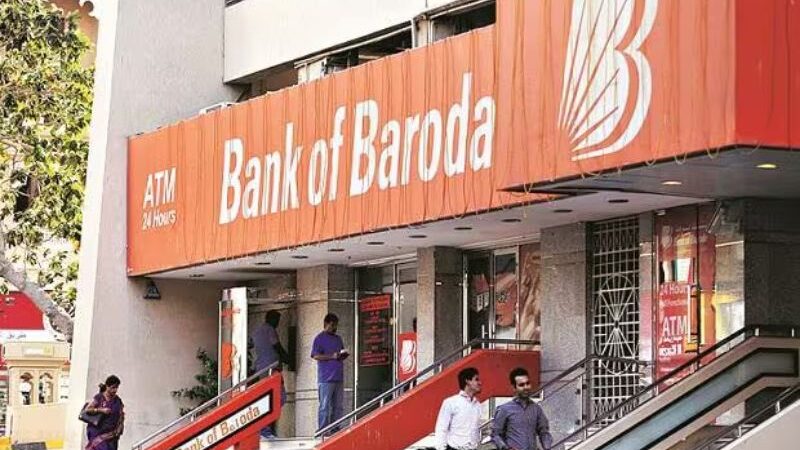Read about Bank of Baroda’s impressive Q1 results, with net profit soaring by 88% to Rs 4,070 crore and a significant improvement in asset quality. Explore the bank’s robust loan growth, reduced slippage ratio, and expanding domestic and international presence in this blog post. Stay informed about the latest financial developments of this leading public sector lender.

Introduction:
Bank of Baroda, one of India’s leading public sector lenders, has reported impressive financial results for the first quarter of FY24. The bank’s net profit witnessed a remarkable 88% growth, reaching Rs 4,070 crore, surpassing market expectations. Moreover, its asset quality showed significant improvement, with gross non-performing assets (NPAs) declining to 3.51% compared to 6.26% last year. In this blog post, we delve into the bank’s Q1 results, highlighting key factors contributing to its success.
Robust Profit Growth and Interest Income:
Bank of Baroda’s net profit for the April-June FY24 quarter surged by 87.7% YoY, amounting to Rs 4,070 crore. The bank’s profitability was supported by healthy interest income, driven by a substantial increase in loan sales and favorable asset repricing. The net interest income (NII) grew by an impressive 24.4% to Rs 10,997 crore, supplemented by strong growth in non-interest income, which surged 2.8 times.
Improvement in Asset Quality:
The bank’s asset quality witnessed significant improvement, with the gross NPA ratio falling by 33.8% to Rs 34,832 crore, accounting for 3.51% of the total book. This represents a substantial decline from 6.26% reported in Q1FY23. Additionally, the net NPA ratio reached a record low of 0.78% in the reporting quarter, compared to 1.58% in Q1FY23. The provision coverage ratio also saw a notable improvement, rising to 93.23 from 78.52 in Q1FY24.
Also Read : Punjab & Sind Bank Q1 Results: Net Profit Declines 25%, but Asset Quality Improves
Slippage Ratio and Credit Cost:
Bank of Baroda reported a decline in the slippage ratio, which measures the rate at which good loans become stressed. The slippage ratio dropped to 1.05% in Q1FY24, down from 1.71% in Q1FY23. A low or negligible slippage rate indicates effective management of asset quality by the bank. Consequently, the credit cost fell by 5 bps to 0.70%, and the bank anticipates it to drop further to under 0.5% by March.
Loan Growth and Business Expansion:
The bank’s loan growth was primarily led by the global book, witnessing an 18% YoY increase to Rs 9,90,988 crore. In contrast, domestic advances recorded a growth of 16.8% YoY, reaching Rs 8,12,626 crore. The bank’s domestic presence spans 8,205 branches and 10,459 ATMs, with an additional international network of 93 overseas offices spanning 17 countries.
Sector-wise Loan Growth:
In the domestic market, Bank of Baroda experienced significant growth in various loan segments. Retail segment loans saw a remarkable surge of 24.8%, driven by substantial growth in auto loans (22.1%), home loans (18.4%), personal loans (82.9%), mortgage loans (15.8%), and education loans (20.8%). Additionally, agricultural loans witnessed an 18% growth to Rs 1,27,583 crore, while the gold loan portfolio rose by 32% to Rs 40,652 crore. The MSME portfolio also grew by 12.7% to Rs 1,09,220 crore.
Conclusion:
Bank of Baroda’s Q1 results have impressed investors and analysts alike, with its net profit witnessing an astounding 88% growth and asset quality showing substantial improvement. The bank’s prudent strategies, robust loan growth, and effective management of asset quality have contributed to its success. As the bank continues to expand its domestic and international presence, it remains poised for further growth in the future. Investors and stakeholders can expect Bank of Baroda to continue its strong performance and deliver value in the financial market.
FAQ – Bank of Baroda Q1 Results and Financial Performance
- What were Bank of Baroda’s Q1FY24 net profit and asset quality? Bank of Baroda reported a 87.7% rise in net profit to Rs 4,070 crore. The bank’s gross non-performing assets declined to 3.51%, showing improved asset quality.
- What contributed to the bank’s profit growth? Healthy interest income from above-industry loan growth and improved margins drove the bank’s profit growth.
- How did the loan portfolio perform in Q1FY24? The global loan book grew by 18% to Rs 9,90,988 crore. Domestic advances rose by 16.8% to Rs 8,12,626 crore.
- What is the slippage ratio and credit cost? The slippage ratio declined to 1.05%, indicating effective asset quality management. The credit cost reduced to 0.70% and is expected to go below 0.5% by March.
- What were the key drivers of domestic loan segment growth? Retail loans grew significantly, with auto loans increasing by 22.1%, home loans by 18.4%, personal loans by 82.9%, and education loans by 20.8% YoY.
- How is Bank of Baroda expanding its business? The bank has a domestic presence with 8,205 branches and 10,459 ATMs, along with an international presence through 93 overseas offices in 17 countries.
- Did the bank meet market expectations? Bank of Baroda’s net profit of Rs 4,070.1 crore fell slightly short of the CNBC-TV18 poll estimate of Rs 4,631.7 crore.
- What does the bank expect for the remaining quarters? The bank projects a 3.3% net interest margin for the remaining quarters, considering repricing of deposits that may impact the spread.
